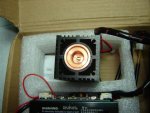Taking a reading with a thermopile you wouldn't know if you had half duty cycle 15w pulses or 7.5w CW, just the average power of 7.5 or 5.4 whatever the number, I wonder if they are actually pulsing the diode albeit a doomed de-canned likely used pull at a higher peak power for short pulse widths of any percentage, I suppose I would need a photocell capable of withstanding the pulses to get a real time peak pulse power reading, not that these are even worth having, what I am thinking about is the possibility of pulsing a LD at higher power for short on time pulses, someone said no yet Alaskan was wanting to do just that with an IR diode, maybe with active cooling it would be possible.
Of course I wouldn't expect to get a million watt spike for a billionth of a second, but maybe a nubm44 diode good for 7w CW could put out 20w pulses at 10000 cycles a second with an ON duration of 10% the pulse width, I get it that the average power would be around 2w but the peak intensity could be 20w pulses, and would that result in an increased ability to do work ?
---edit---
It should look a lot brighter to our eye if possible to do with our MM diodes, even if doing useful work was not in the realm of possibility at the aforementioned level.





